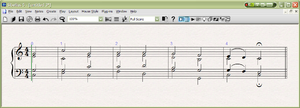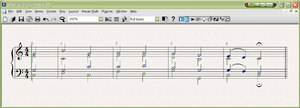Sibelius: Chorale: Difference between revisions
Jump to navigation
Jump to search
No edit summary |
No edit summary |
||
| Line 8: | Line 8: | ||
Follow [[Media:Sibelius3.pdf |these instructions]] to enter the music for the first few bars of the chorale <i>Dir, dir, Jehovah, will ich singen</i>. The final result should look similar to the image displayed to the right. | Follow [[Media:Sibelius3.pdf |these instructions]] to enter the music for the first few bars of the chorale <i>Dir, dir, Jehovah, will ich singen</i>. The final result should look similar to the image displayed to the right. | ||
== Additional notes == | |||
* When in Note Entry mode, pressing {{keypress|Alt|1}}/{{keypress|2}}{{keypress|3}}/{{keypress|4}} (Use {{keypress|{{Option}}}} on a Mac) will switch to input in specified voice number. These key commands can be used to move notes between voices outside of Note Entry mode. | |||
* A fermata is added to a note by typing {{keypress|F11}} to set the keypad to articulations, then pressing {{keypress|keypad 1}} to select a fermata. This has to be done before adding a note to the staff. | |||
Latest revision as of 20:33, 26 October 2010


This is the third exercise for entering music in Sibelius using Alphabetic Note Entry. The previous exercise is Bach's prelude in F minor.
This example demonstrates how to enter more than one voice onto a staff.
Follow these instructions to enter the music for the first few bars of the chorale Dir, dir, Jehovah, will ich singen. The final result should look similar to the image displayed to the right.
Additional notes
- When in Note Entry mode, pressing Alt+1/23/4 (Use ⌥ on a Mac) will switch to input in specified voice number. These key commands can be used to move notes between voices outside of Note Entry mode.
- A fermata is added to a note by typing F11 to set the keypad to articulations, then pressing keypad 1 to select a fermata. This has to be done before adding a note to the staff.